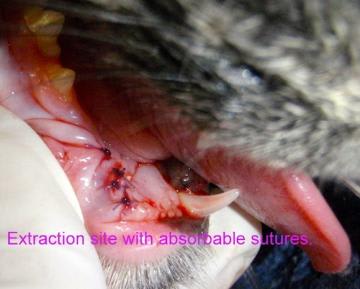Sissy is a friendly, engaging, robust 17 pound cat who lives in Johnson City, TN. She was adopted by her family as a rescue, and she serves as an excellent example of the many wonderful, loving cats that can be adopted. Sissy’s mom brought her in to Animal Hospital of North Asheville last week for an appointment for a dental evaluation and tooth cleaning, and her case points out some important characteristics of cats.
Sissy arrived at our hospital for dental care by Dr. David Thompson due to findings during her annual comprehensive physical exam. On physical exam, Dr. Earley had found a broken tooth, which is a painful dental problem, as well as tartar and gingivitis.
Blood tests performed at the time of her annual exam identified that she was healthy with no known risk factors for anesthesia.


As you can see in the picture taken after Sissy was under general anesthesia, the lower right canine tooth (even in cats it is called a canine tooth) is fractured near the tip.
A tooth fracture in a dog or cat can be complicated or uncomplicated. In an uncomplicated fracture, the fracture is shallow so that the dentin (just below the enamel) is exposed but the fracture does not enter the root canal or pulp cavity.
In people, we know that this type of fracture causes sensitivity of the tooth and there is an increased risk of deep tooth infection. There is a simple treatment for these shallow fractures that eliminates discomfort and risk of infection.
Sissy, unfortunately, had a complicated fracture, meaning the root canal/pulp cavity is exposed. One characteristic of cats is that they seldom have uncomplicated fractures of their teeth.
In cats, the pulp cavities are very close to the surface of each tooth so it is rare that a fracture does not enter the root canal. Another characteristic of cats is that they seldom show any outward signs of oral discomfort. Experts theorize that in nature, showing pain or weakness encourages predators to attack and also signals other animals to take advantage of the situation by taking food from or ostracizing the affected animal.
People describe the initial pain of a complicated fractured tooth as initially extreme and after a day or two as a dull throbbing pain which lasts for days, months or years until corrected.
Even though Sissy’s family is extremely attentive, Sissy showed no obvious sign of pain. Sissy’s family had two choices to eliminate her pain: Have Sissy undergo a root canal or extract the tooth. Most families opt, as Sissy’s did, to extract the tooth.
Because cats have longer, thinner, more delicate roots than people do, every extraction in a cat requires a lengthy, careful, precise surgical procedure.
After Sissy was under general anesthesia, an x-ray of the tooth and root was performed to confirm that the tooth did indeed need to be extracted and to eliminate any surprises during surgery such as a broken root.
You can see there is a dark halo around the root tip (see the dots outlining it). This is where bacteria entered the tooth at the fracture site, traveled to the root tip and began destroying the bone in that area. The dark halo is termed a periapical abscess. The halo indicates that infection has been present for a year or longer. Sissy must have been in pain for a long time, yet Sissy’s very attentive and loving mom had no way to know.

Important Points:
- Every fractured tooth is uncomfortable and requires treatment.
- We cannot assume our pet will indicate oral discomfort or even oral pain. Even tartar is uncomfortable.
- A study performed at the University of Pennsylvania indicated that 10% of dogs have at least one fractured tooth during their lifetime. There is not a fracture study in cats but 70 % have periodontal disease by 3 years of age. Oral disease is common even in young cats and dogs.
Once the gas anesthesia was turned off, Sissy was awake yet sleepy in Dr. Thompson’s arms within minutes. Pain during dental surgery is prevented with nerve blocks, which numb the surgery site so general anesthesia can be kept light for safety, and a soothing narcotic, which is given before the procedure and sent home to maintain comfort during healing.
Sissy went home that same day, comfortable and relaxed and free of pain.

